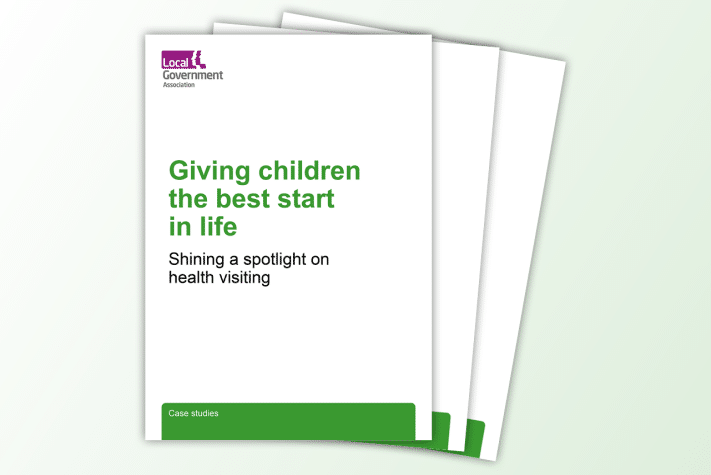17th May 2024
Read the latest iHV Voices blog by Emily Hackett, Adviser – Public Health at the Local Government Association, on their work to shine a spotlight on the important role that health visitors play in improving health and reducing inequalities.

The Local Government Association (LGA) has recently published a series of seven case studies illustrating the pivotal role that health visitors play in ensuring children and families get the support they need in challenging times.
The health visiting service plays a crucial role in giving children the best start in life.
Health visitors are vital health assets in our communities. They play a key role in identifying needs, promoting and improving health, preventing illness and reducing inequalities – helping our babies and children to thrive. At a time of increasing need and complexity, health visiting teams are needed now more than ever.
In the years since health visiting was brought into local government, we have seen councils develop new ways of working, integrating health visiting with other early years services. Many areas have developed specialist posts for vulnerable groups, for example, such as targeted, intensive health visiting support to families accessing drug or alcohol treatment.
For example, in County Durham, in response to perinatal and infant mental health challenges, Durham County Council’s commissioned health visiting service has significantly advanced its care delivery through a skill mix model and the introduction of specialised roles. Their new initiative focuses on early intervention and improving parent-infant relationships, capitalising on a number of evidence-based practices to support family mental health needs.
In Hertfordshire, in response to national workforce and recruitment challenges, the council and the public health nursing team are working with the local university to build working partnerships with student nurses currently in training. This would create a route to successfully place students into the service and retain or employ students after they have qualified.
Lancashire’s local priority for best start in life has redefined services by integrating health visiting, early years, maternity and family hubs within a unified framework led by the Best Start in Life (BSIL) Board. This strategic shift, aimed at improving school readiness and reducing inequalities, highlights the benefits of collaborative governance and data-driven insights to enhance service delivery.
In Derbyshire, novel partnerships developed (such as with Citizens Advice) offer families tailored support for complex social and economic challenges, whilst the adoption of digital tools bridges communication gaps, making health services more accessible and user-friendly for families.
In Doncaster, the health visiting team proactively measures performance both qualitatively and quantitatively to find ways to continually improve the service and understand changing local needs. Integrating insights from social media engagement through the provider has been an innovative way to capture these needs and areas of focus.
In Sefton, the provider Mersey Care’s health visiting services have embarked on an evolving journey, to address deep rooted challenges such as poverty, health inequalities and logistical complexities of service delivery across a diverse borough.
Finally, in Wolverhampton, the council revolutionised its health visiting services through a ten-year strategic partnership with the Royal Wolverhampton NHS Trust (RWT), transforming the delivery of the Healthy Child Programme.
These innovations – covered in detail in the case study pages above – are having an enormous impact on the lives of families and the development of infants, and are testament to the outstanding role of health visitors in our communities.
However, major challenges remain.
Official data shows national rates of child development are now lower among two-year-olds than they were in 2018-19, before the pandemic, with more than 80,000 children born in 2020-21 failing to reach one or more of the key measures of progress for their age group.
What is more, the number of health visitors in post is falling and it is clear that councils are struggling to recruit and retain sufficient health visitors.
Alarmingly, between 2015 and 2022, the health visiting workforce decreased by nearly 40 per cent. Contributing factors include cuts to the public health grant, reduced numbers of training places, retirement, and staff moving to other roles.
On 30 June 2023, the Government published their long-awaited NHS Long Term Workforce Plan which included detail around increasing the number of education and training places for health visitors by 2030/31. Councils welcome these commitments – but need more details on implementation and funding.
The LGA has continued to repeat calls to Government to reverse the almost £900 million of public health grant cuts since 2015, to enable councils to strengthen and rebuild the health visiting workforce and ensure we can continue to support families when they need us most.
Investing in services that give children the best start in life reduces demands on GPs, hospitals and social care. It means children start school ready to learn and to achieve, so our schools can be more effective. Investing at the start of life gives our children the best chance of being safe, happy and healthy throughout their lifetime and into old age.
It just goes to show how important health visiting is to the life chances of children – and why councils must do all they can to ensure the best support is provided.
These case studies are evidence of the commitment and resilience of health visitors and their teams. They illustrate the pivotal role health visitors play in ensuring children and families get the support they need in challenging times.
Emily Hackett, Adviser – Public Health, Local Government Association
To submit a case study to feature on the LGA website, please email [email protected]






